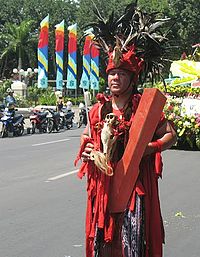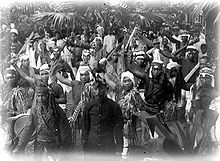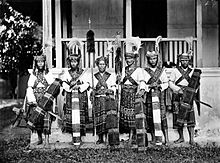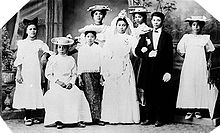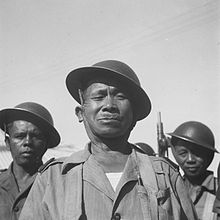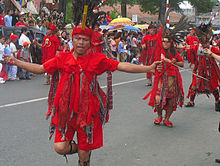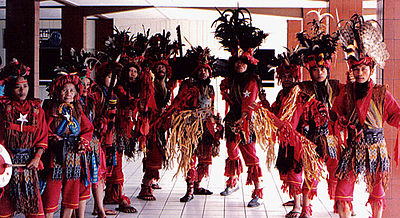- Minahasa people
-
Minahasa Minahasan tribesman in a parade in Surabaya, East Java. Total population ca. 1 million in North Sulawesi Regions with significant populations Indonesia (predominantly North Sulawesi), Netherlands Languages Religion Protestantism (89%), Roman Catholicism (10,5%), Islam (0,5%)
Related ethnic groups Mongondow people, Gorontalonese people
The Minahasa (alternative spelling: Minahassa or Mina hasa) are an ethnic group located in the North Sulawesi province of Indonesia, formerly known as North Celebes. The Minahasa speak Minahasan languages and Manado Malay (also known as Minahasa Malay), a language closely related to the Malay language.
Minahasa Raya is the area covering Bitung City, Manado City and Minahasa Regency, which are three of the seven regional administrations in the province of North Sulawesi, Indonesia.
Originally inhabited by Nuclear Malayo-Polynesian languages-speaking peoples, the region was colonized in the 16th century by the Portuguese and Spanish, then the Dutch. In the Dutch East Indies the Minahasa people identified strongly with the Dutch language, culture and the Protestant faith — so strongly, in fact, that when Indonesia became independent in 1945 factions of political elites of the region pleaded with the Dutch to let it become a province of the Netherlands.[1] The centuries old strong bond between the Minahasa and the Netherlands has recently been studied and explained using the Stranger King concept.
There is a considerable number of people from the Minahasa living in the Netherlands, as part of the Indo (Eurasian) community.[2]
Contents
History
The name of the land of Minahasa has been changed several times: Batacina-Malesung-Minaesa and then finally the current name Minahasa, meaning "becoming one united". This name dates from the war against the southern Kingdom of Bolaang Mangondow. However, other sources cite that the original name of Minahasa was Malesung, meaning "paddy rotary", then changed to Se Mahasa, meaning "they that unite," and finally Minahasa, meaning "becoming one united."[3]
North Sulawesi never developed any large empire. In 670, the leaders of the different tribes, who all spoke different languages, met by a stone known as Watu Pinawetengan. There they founded a community of independent states, who would form one unit and stay together and would fight any outside enemies if they were attacked.[4]
Untill well into the 18th century the Minahasa was made up of rivaling warrior societies that practiced headhunting.[5]
The Origin of Minahasa People
It is unknown when the land of Minahasa was first occupied by humans. The Minahasans believe that they are descendants of Toar and Lumimuut. Initially, the descendants of Toar-Lumimuut were divided into 3 groups: Makatelu-pitu (three times seven), Makaru-siuw (two times nine) and Pasiowan-Telu (nine times three). They multiplied quickly. But soon there were disputes among these people. Their leaders (Tona'as) then decided to meet and talk about this. They met in Awuan (north of the current Tonderukan hill). That meeting was called Pinawetengan u-nuwu (dividing of language) or Pinawetengan um-posan (dividing of ritual). At that meeting the descendants were divided into three groups named Tonsea, Tombulu, and Tontemboan corresponding to the groups mentioned above. At the place where this meeting took place a memorial stone called Watu Pinabetengan (Stone of Dividing) was then built. It is a favourite tourist destination.
The groups Tonsea, Tombulu, and Tontemboan then established their main territories which were Maiesu, Niaranan, and Tumaratas respectively. Soon several villages were established outside these territories. These new villages then became a ruling center of a group of villages called puak, later walak, comparable to the present-day district.
Subsequently a new group of people arrived in Pulisan peninsula. Due to numerous conflicts in this area, they then moved inland and established villages surrounding a large lake. These people were therefore called Tondano, Toudano or Toulour (meaning water people). This lake is now the Tondano lake.
In the following years, more groups came to Minahasa. There were:
- people from the islands of Maju and Tidore who landed in Atep. These people were the ancestors of the subethnic Tonsawang.
- people from Tomori Bay. These were the ancestors of the subethnic Pasam-bangko (Ratahan dan Pasan)
- people from Bolaang Mangondow who were the ancestors of Ponosakan (Belang).
- people from the Bacan archipelago and Sangi, who then occupied Lembeh, Talisei Island, Manado Tua, Bunaken and Mantehage. These were the subethnic Bobentehu (Bajo). They landed in the place now called Sindulang. They then established a kingdom called Manado which ended in 1670 and became walak Manado.
- people from Toli-toli, who in the early 18th century landed first in Panimburan and then went to Bolaang-Mangondow
- and finally to the place where Malalayang is now located. These people were the ancestors of the subethnic Bantik.
These are the nine sub-ethnic groups in Minahasa (which explains the number 9 in Manguni Maka-9):
- Tonsea,
- Tombulu,
- Tontemboan,
- Tondano,
- Tonsawang,
- Pasan Ratahan (Bentenan),
- Ponosakan,
- Babontehu,
- Bantik.
Eight of these ethnic groups are also separate linguistic groups.
The name Minahasa itself arose at the time the Minahasans fought against Bolaang Mangondow. Among the Minahasan heroes in these wars against Bolaang Mangondow are: Porong, Wenas, Dumanaw and Lengkong (in the war near Lilang village), Gerungan, Korengkeng, Walalangi (near Panasen, Tondano), Wungkar, Sayow, Lumi, and Worotikan (in the war along Amurang Bay).
Until the dominance of Dutch influence in the 17th and 18th century the Minahassans lived in warrior societies that practised headhunting.[6]
The European Era
In the second half of the 16th century, both Portuguese and the Spanish arrived in North Sulawesi. Half-way though the 17th century there was a rapprochement between the Minahasan chiefs and the Dutch VOC (Verenigde Oostindische Compagnie), which was given concrete form in the treaty of 1679 (which can be found in the Corpus Diplomaticus Neerlando-Indicum 1934, vol. III, no 425). From 1801-1816, the Netherlands were occupied by the French imperial forces of Napoleon and the Minahasa came under English control. In 1817 Dutch rule was re-established until 1949.
At the time of the first contact with Europeans the sultanate of Ternate held some sway over North Sulawesi, and the area was often visited by seafaring Bugis traders from South Sulawesi. The Spanish and the Portuguese, the first Europeans to arrive, landed in Minahasa via the port of Makasar, but also landed at Sulu Island (off the north coast of Borneo) and at the port of Manado. The abundance of natural resources in Minahasa made Manado a strategic port for European traders sailing to and from the spice island of Maluku. Although they had sporadic contacts with Minahasa, the Spanish and Portuguese influence was limited by the power of the Ternate sultanate.
The Portuguese and Spaniards left reminders of their presence in the north in subtle ways. Portuguese surnames and various Portuguese words not found elsewhere in Indonesia, like garrida for an enticing woman and buraco for a bad man, can still be found in Minahasa. In the 1560s the Portuguese Franciscan missionaries made some converts in Minahasa.
The Spanish had already set themselves up in the Philippines and Minahasa was used to plant coffee that came from South America because of its rich soil. Manado was further developed by Spain to become the center of commerce for the Chinese traders who traded the coffee in China. With the help of native allies the Spanish took over the Portuguese fortress in Amurang in the 1550s, and Spanish settlers also established a fort at Manado, so that eventually Spain controlled all of the Minahasa. It was in Manado where one of the first Indo-Eurasian (Mestizo) communities in the archipelago developed during the 16th century.[7] The first King of Manado (1630) named Muntu Untu was in fact the son of a Spanish Mestizo. [8]
Spain renounced to her possessions in Minahasa by means of a treaty with the Portuguese in return for a payment of 350,000 ducats.[9] Minahasan rulers sent Supit, Pa'at dan Lontoh (their statues are located in Kauditan, about 30 km to Bitung) where they made an alliance treaty with the Dutch. Together eventually gained the upper hand in 1655, built their own fortress in 1658 and expelled the last of the Portuguese a few years later.
By the early 17th century the Dutch had toppled the Ternate sultanate, and then set about eclipsing the Spanish and Portuguese. As was the usual case in the 1640s and 50s, the Dutch colluded with local powers to throw out their European competitors. In 1677 the Dutch occupied Pulau Sangir and, two years later, the Dutch governor of Maluku, Robert Padtbrugge, visited Manado. Out of this visit came a treaty with the local Minahasan chiefs, which led to domination by the Dutch for the next 300 years although indirect government only commenced in 1870.
The Dutch helped unite the linguistically diverse Minahasa confederacy, and in 1693 the Minahasa scored a decisive military victory against the Bolaang to the south. The Dutch influence flourished as the Minahasans embraced European culture and Christian religion. Missionary schools in Manado in 1881 were among the first attempts at mass education in Indonesia, giving their graduates a considerable edge in gaining civil service, military and other positions of influence.
Relations with the Dutch were often less than cordial (a war was fought around Tondano between 1807 and 1809) and the region did not actually come under direct Dutch rule until 1870. The Dutch and the Minahasans eventually became so close that the north was often referred to as the 12th province of the Netherlands. A Manado - based political movement called Twaalfde Provincie even campaigned for Minahasa's integration into the Dutch state in 1947.
Portuguese activity apart, Christianity became a force in the early 1820s when a Calvinist group, the Netherlands Missionary Society, turned from an almost exclusive interest in Maluku to the Minahasa area. The wholesale conversion of the Minahasans was almost complete by 1860. With the missionaries came mission schools, which meant that, as in Ambon and Roti, Western education in Minahasa started much earlier than in other parts of Indonesia. The Dutch government eventually took over some of these schools and also set up others. Because the schools taught in Dutch, the Minahasans had an early advantage in the competition for government jobs and places in the colonial army. Minahasans remain among the educated elite today.
Armed Forces
A relatively large number of Minahasans pursued professional military careers in the colonial army (KNIL). Next to the South Moluccan Ambonese, the Minahasa Menadonese were also considered a martial race and therefore particularly competent and trustworthy as soldiers. As KNIL soldiers the Minahasans fought alongside the Dutch to subdue rebellions in other parts of the archipelago, such as for instance the Java War of 1825-30.
As a large percentage of Minahasans was formally equalised to the European legal class, young men were also obliged to serve as conscripts when mandatory military service for Europeans was introduced in 1917. Older men (as off 32) were obliged to join the Home guard (Dutch: Landstorm).
During the Japanese occupation of the Dutch East Indies in WWII many Menadonese soldiers were held captive as POW's.
They seemed to gain a special role in the Dutch scheme of things and their loyalty to the Dutch as soldiers, their Christian religion and their geographic isolation from the rest of Indonesia all led to a sense of being 'different' from the other ethnic groups of the archipelago.[clarification needed]
Republic of Indonesia
The Japanese occupation of 1942-45 was a period of deprivation, and the Allies bombed Manado heavily in 1945. During the Revolution for independence that followed, there was bitter division between pro-Indonesian Unitarians and those favoring Dutch-sponsored federalism. The appointment of a Manadonese Christian, Sam Ratulangi, as the first republican governor of eastern Indonesia, was decisive in winning Minahasan support for the republic. A contra-revolution such as the Republik Maluku Selatan one in the Moluccas was averted.
As the young republic lurched from crisis to crisis, Jakarta's monopoly over the copra trade seriously weakened Minahasa's economy. As in Sumatra, there was a general feeling that the central government was inefficient, development was stagnating and money was being plugged into Java. Circumstances favored the spread of communism.[citation needed]
Illegal exports flourished and in June 1956 Jakarta ordered the closure of Manado port, the busiest smuggling port in the republic. Local leaders refused and Jakarta backed down. Soon Permesta rebels confronted the central government with demands for political, economic and regional reform. Jakarta responded by bombing Menado city in February 1958, and then invading the Minahasa in June 1958, but were only able to end the Permesta revolt in 1961.
Permesta
In March 1957, the military leaders of both southern and northern Sulawesi launched a confrontation with the central government, with demands for greater regional autonomy. They demanded more local development, a fairer share of revenue, help in suppressing the Kahar Muzakar rebellion in Southern Sulawesi, and a cabinet of the central government led jointly by Soekarno and Hatta. At least initially the 'Permesta' (Piagam Perjuangan Semesta Alam) rebellion was a reformist rather than a separatist movement.
Negotiations between the central government and the Sulawesi military leaders prevented violence in southern Sulawesi, but the Minahasan leaders were dissatisfied with the agreements and the movement split. Inspired, perhaps, by fears of domination by the south, the Minahasan leaders declared their own autonomous state of North Sulawesi in June 1957. By this time the central government had the situation in southern Sulawesi pretty much under control but in the north they had no strong local figure to rely upon and there were rumors that the USA, suspected of supplying arms to rebels in Sumatra, was also in contact with the Minahasan leaders.
The possibility of foreign intervention finally drove the central government to seek military support from southern Sulawesi. Permesta forces were driven out of central Sulawesi, Gorontalo, Sangir island and from Morotai in Maluku (from whose airfield the rebels had hoped to fly bombing raids on Jakarta). The rebels' few planes (supplied by the USA and flown by Filipino, Taiwanese and US pilots) were destroyed. US policy shifted, favoring Jakarta, and in June 1958 central government troops landed in Minahasa. The Permesta rebellion was finally put down in mid-1961.
The effect of both the Sumatran and Sulawesi rebellions was to strengthen exactly those trends the rebels had hoped to weaken. Central authority was enhanced at the expense of local autonomy, radical nationalism gained over pragmatic moderation, the power of the communists and Soekarno increased while that of Hatta waned, and Soekarno was able to establish guided democracy in 1959.
Recently, the Indonesian government has adopted policies to strengthen local autonomy, the very idea that Permesta fought for.
Culture
Religion
At 97% of the population, the Minahasa Regency has one of highest proportions of Christianity in Indonesia. It has the highest density of church buildings in Indonesia, with approximately one church for every 100m road.[citation needed] This is due to a successful missionary campaign by European Christians in Northern Sulawesi.
In 1907, Firma P.W.M Trap, Leiden, Holland published a bible in the Tontemboan language, a language of Minahasa. It was edited by M. Adriani-Gunning and J. Regar.
Jehovah's Witnesses begin their first preaching activity in this province in 1932. The first Minahasa to be baptized was Brother Theo Ratu; he is also claimed as the first Indonesian to be baptized. His son Vicky Ratu was also one of the Jehovah's Witnesses, now joined in Tangerang Kota Congregation. In the 2007 Service Year in North Sulawesi their peak publisher figures were 2,500 publishers.
Cuisine
Minahasan cuisine is very spicy, and can feature ingredients not typically found in other parts of Indonesia. For example, dog (RW, short for rintek wuuk, or "fine hair" in Tontemboan), cat (tusa', also known as eveready because of the cat logo used by the battery), forest rat, and fruit bat (paniki) are commonly eaten. The provincial capital Manado is often referred to as Kota Tinutuan, in reference to a popular local dish: a rice porridge made with corn, smoked fish, greens, and chilies. Known outside the province as Bubur Manado, tinutuan is supposed to improve health and vitality.
Dance
Kabasaran is the fierce and famous Minahasan wardance which reminds of the old Minahasa warrior societies. The dancers wear red garments which in the old times was a color exclusive for the accomplished headhunter. This dance is similar to the Moluccan Cakalele wardance.[16]
Music
Minahasa music is highly influenced by that of the European colonials; their festivals feature large marching ensembles made up of clarinets, saxophones (source), trumpets, trombones, and tubas, all constructed out of local bamboo.[17]
Languages
In the Minahasa, 5 distinct languages are spoken: Tonsawang, Tontemboan, Toulour, Tonsea and Tombulu. In 1996, the Summer Institute of Linguistics in Dallas, published the North Sulawesi Language Survey by Scott Merrifield and Martinus Salea. It gives an overview of the classification and distribution of the languages, based on a detailed study of the phonology and vocabulary.[18]
Influences of Portuguese, Spanish and Dutch can be found in the Indonesian dialect of the Minahasa (Manado Malay or Minahasa Malay):
Chair in Indonesian is kursi, in the Minahasa its called kadera (cadera - Spanish word for hip; cadeira - Portuguese word for chair).
Horse in Indonesian is kuda, a word of Sanscrit origin. In the town of Tomohon, a horse is called kafalio (caballo - Spanish, cavalo - Portuguese).
There is not much known yet about the ideogramatical Minahasa writing system, its origin or translation.[19]
Cultural revival
Ever since the overall de-centralisation following the end of Suharto's New Order era the Minahasa is bolstering its regional autonomy scheme, among others by positioning itself to profile a unique cultural entity & identity. The three main Minahasa NGO's active in the cultural revival movement are: 'Yayasan Suara Nurami' (The Voice from Within Foundation); 'Minahasa Wangko' (Minahasa the Great) both founded by Bert Supit and 'Peduli Minahasa' (Take care of Minahasa).[20]
National Heroes of Indonesia from Minahasa
- Alexander Evert Kawilarang
- Arie Frederik Lasut
- Alexander Andries Maramis
- Maria Walanda Maramis
- Daan Mogot
- Robert Wolter Monginsidi
- Lambertus Nicodemus Palar
- Sam Ratulangi
- Pierre Andries Tendean
- Wenas
- Dumanaw
See also
References
- ^ http://www.cityu.edu.hk/searc/WP19_02_Jacobsen.pdf Document
- ^ Minahassers in Indonesië en Nederland: migratie en cultuurverandering, Menno Hekker, Disertasi Universiteit van Amsterdam, 1993
- ^ Paul Richard Renwarin, Matuari Wo Tonaas (Jakarta, Indonesia: Penerbit Cahaya pineleng, 2007), p. 1
- ^ Roderick C. Wahr, History Timeline Minahasa Website
- ^ Schouten, M.J.C. Leadership and Social Mobility in a Southeast Asian society. Minahasa, 1677-1983. P.11 (KITLV Press, Leiden, 1998) ISBN 90 6718 109 9
- ^ 'Leadership and social mobility in a southeast asian society', by M.J.C Schouten, ISBN 9067181099
- ^ Wahr, C.R. Minahasa (history) Website
- ^ Wahr, C. R. Minahasa (history) Website
- ^ Milburn, William (1813). Oriental commerce: containing a geographical description of the principal places in the East Indies, China, and Japan, with their produce, manufactures, and trade. New York: Black, Parry & Co. pp. 406.
- ^ Government of Minahasa Regency
- ^ F.S. Watuseke: Sedjarah Minahasa. Tjetakan kedua. Manado, 1969.
- ^ Godee Molsbergen, E.C. : Geschiedenis van de Minahasa tot 1829, 1928.
- ^ Schouten, Mieke: Minahasa and Bolaangmongondow, Martinus Nijhoff, The Hague, 1981.
- ^ Arsip Nasional RI No. 134, 162, 169.
- ^ Minahasa website (English and Indonesian language)
- ^ The Minahasa - Sociale Struktuur - De Kabasaran Dans
- ^ http://www.minahasaraya.net/frame1.htm?http&&&www.minahasaraya.net/bamboo.htm Minahasa website
- ^ North Sulawesi Language Survey, by Scott Merrifield, Martinus Salea, 1996
- ^ Minahasa writing system
- ^ Jacobson, On the Question of Contemporary Identity in Minahasa, North Sulawesi Province, Indonesia. (Asian Anthropology, Vol 1, 2002.)[1]
External links
Categories:- Ethnic groups in Indonesia
- North Sulawesi
Wikimedia Foundation. 2010.

